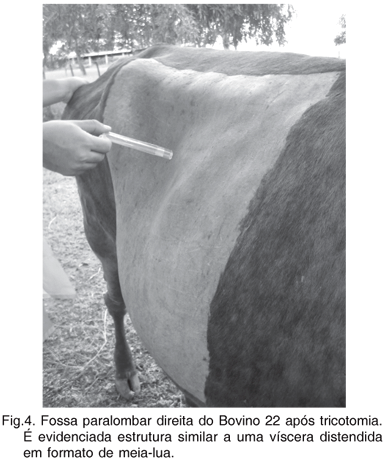The continuous genetic selection for high milk production in association with greater digestive capacity and corporal depth increases the susceptibility for abomasopathies including abomasal displacement. The present work aimed to accomplish a retrospective study on abomasal displacement in 36 cattle attended at Bovine Clinic, Garanhuns Campus, Federal Rural University of Pernambuco, through January 2000 to February 2009. Twenty seven cases of right abomasal displacement, six cases of left abomasal displacement and three of abomasal volvulus were diagnosed. Eleven moderate cases, without severe abdominal distention, appetite for roughage and metallic sound (“ping”) reaching at the most the 8th intercostal space were treated conservatively, and 20 severe cases with moderate to severe abdominal distention associated to systemic disturbances were treated surgically. Two cows were euthanized due to diffuse peritonitis or severe alterations in the abomasal serosa totalizing 18 animals submitted to the surgical treatment. Two animals were slaughtered and three cows arrived prostrated and died without receiving any treatment. Risk factor analysis identified rainy season as statistically significant. The greater number of abomasal displacement was in crossbred cows with 24 cases (66.6%), followed by Holstein and Gir cattle with 11 (30.5%) and one (2.9%) cases, respectively. Food composition varied greatly and characterized by excess of carbohydrates and in most cases low quality fibers. Most frequent clinical signs were apathy, dehydration, light to severe ruminal bloat with reduced or absent motility, splashing sound during right flank ballottement, ping and a distended viscera-like structure in the side of the displacement; liquid, blackish and fetid feces. Hematology reveals leukocytosis with neutrophilia and hyperfibrinogenemia in most cases. Ruminal fluid analysis showed compromised flora and fauna dynamics and increased chloride ion concentration in 93.9% of the cases achieving the media index of 47.66 mEq/L. Clinical and surgical recovery rate achieved 100% and 72.2%, respectively. Those methods described are viable options for the treatment of light and severe displacements but the prevention remains the best choice.
Abomasopathies; clinical findings; hematology; risk factors; ruminal fluid analysis; pyloro-omentopexy








